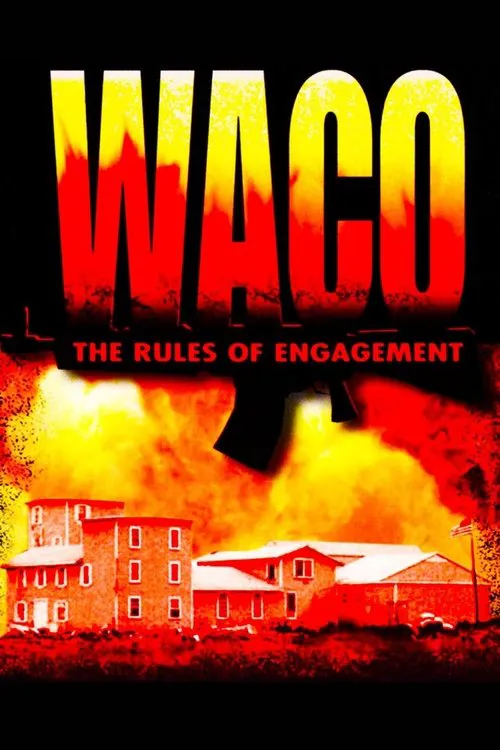Waco: The Rules of Engagement

Plot
On a crisp spring morning in 1993, the sleepy town of Waco, Texas, was the stage for a drama that would unfold with tragic consequences. At the heart of the drama was the Branch Davidian sect, led by the charismatic and enigmatic David Koresh. The sect had drawn international attention due to their unconventional beliefs and practices, and the media had taken a keen interest in their activities. The Branch Davidians were a part of the Seventh-day Adventist Church, but they had developed their own distinct theology and practices, which were deemed heretical by the mainstream church. They believed in a messianic figure who would lead them to a new world order, and Koresh was their chosen leader. The sect had taken up residence on a 77-acre ranch on the outskirts of Waco, where they lived a communal life, adhering to a strict code of conduct. In the weeks leading up to the fateful day of April 19, 1993, the tension between the Branch Davidians and the authorities had been escalating. The sect had been under surveillance by the Bureau of Alcohol, Tobacco, and Firearms (ATF), which had been gathering evidence of possible gun violations. A search warrant was issued for the Waco ranch, and a team of ATF agents was dispatched to serve it. On February 28, 1993, the ATF team arrived at the ranch in a show of force, armed with M16 rifles and wearing flak jackets. They were met with resistance from the Branch Davidians, who were armed and determined to defend their home. The ensuing shootout left four ATF agents dead and 16 injured. The Branch Davidians also suffered heavy losses, with an estimated six to 16 members killed and several others injured. The aftermath of the raid saw the arrival of the FBI, which had been called in to handle the situation. The FBI's tactical teams, known as the Hostage Rescue Team (HRT), were deployed to the ranch, and a perimeter was established around the site. The Branch Davidians, who were now trapped inside their compound, refused to surrender, citing a fear of persecution and a desire to live in accordance with their principles. As the standoff dragged on, the media descended on Waco, eager to capture the drama unfolding before their eyes. The government, under pressure from Congress and the media, sought to justify their actions and downplay the severity of the situation. However, it became increasingly clear that the situation was spiraling out of control. The FBI's strategy, as led by the Assistant Director of the FBI's Crisis Management Unit, Jeffrey Jamar, was to negotiate a peaceful resolution, while also maintaining a military-style lockdown on the perimeter of the compound. The strategy involved providing food and other supplies to the Branch Davidians in an effort to persuade them to surrender. However, this tactic had an unexpected consequence: it inadvertently fueled the paranoia and distrust of the sect members, who saw the supplies as an attempt to starve them into submission. Meanwhile, the FBI's use of tear gas on April 19, 1993, marked a turning point in the drama. The FBI, having run out of options, decided to launch a massive assault on the compound, using armored vehicles and pyrotechnics to blast through the walls of the complex. The Branch Davidians, caught off guard, were caught in a maelstrom of fire and smoke, which raged for hours. The outcome was disastrous. The 51-day standoff ended in a blaze of fire that destroyed the compound, killing an estimated 76 Branch Davidians, including children, women, and infants. The government's handling of the situation was widely condemned, with many critics accusing the FBI of gross incompetence and excessive force. In the aftermath of the tragedy, the government set up an inquiry into the events leading up to the Waco debacle. The investigation, carried out by the Senate Committee on the Judiciary, revealed a series of bureaucratic lapses and strategic blunders that contributed to the catastrophic outcome. The report also questioned the tactics employed by the FBI and the ATF, and called for a more nuanced and balanced approach to dealing with extremist groups. The documentary "Waco: The Rules of Engagement" sheds light on the complex events leading up to the tragedy, and it provides a chilling account of the FBI's unrelenting approach, which exacerbated the situation. By examining the available footage and recordings, the documentary exposes the deepening crisis, as the Branch Davidians became more isolated and desperate. As the documentary unfolds, a clear picture emerges of the flawed handling of the situation by the authorities. The Branch Davidians, who had initially been willing to negotiate, became increasingly paranoid and radicalized as the situation descended into chaos. The FBI's inflexibility and unwillingness to compromise contributed to the escalating tensions. The events at Waco serve as a powerful reminder of the risks involved in law enforcement operations, particularly when dealing with groups that are deeply entrenched and unwilling to compromise. The documentary serves as a cautionary tale, highlighting the dangers of hubris and the importance of empathy and understanding in high-pressure situations. The aftermath of the Waco tragedy has had a profound impact on American society. The incident led to widespread outrage and calls for greater transparency and accountability in government operations. The 1995 Oklahoma City bombing, perpetrated by Timothy McVeigh, a former Gulf War veteran and anti-government extremist, was linked to the Waco tragedy, highlighting the dangers of domestic terrorism. In the years since, law enforcement agencies have revised their strategies for dealing with extremist groups, incorporating more nuanced and empathetic approaches that prioritize communication and de-escalation. The Waco tragedy remains a powerful reminder of the importance of learning from past mistakes and adapting to new challenges, as the complex and ever-changing landscape of extremism demands flexible and effective responses.
Reviews




